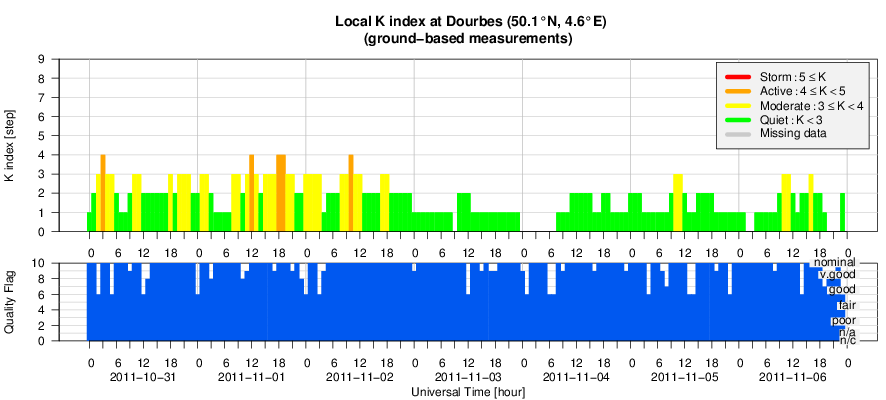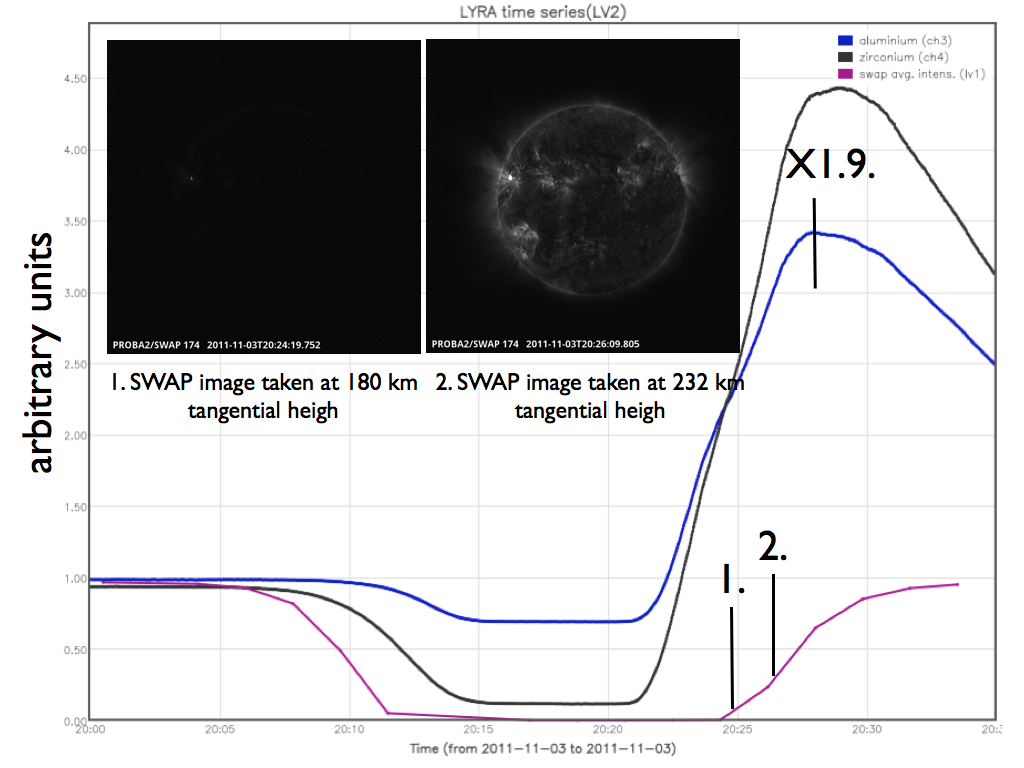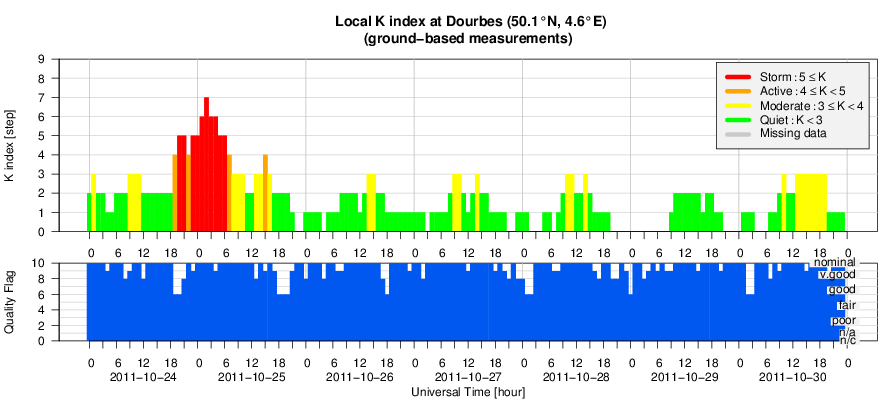
The Solar Terrestrial Center of Excellence (STCE) is a collaborative network of the Royal Observatory of Belgium, the Belgian Institute for Space Aeronomy and the Belgian Royal Meteorological Institute.
 |
Published by the STCE generally on thursday (this issue : 10 Nov 2011). The Solar Terrestrial Center of Excellence (STCE) is a collaborative network of the Royal Observatory of Belgium, the Belgian Institute for Space Aeronomy and the Belgian Royal Meteorological Institute. |
| Archive of the newsletters | |

The ESA micro-satellite PROBA2 (see http://proba2.sidc.be) observes the solar corona from a low Earth orbit. This orbit includes an eclipse season, roughly from November to February in which a fraction of each 99min orbit is occulted by the Earth shadow.
On Nov 3, an X1.9 flare happened, according to NOAA it started 20:16, peaked at 20:27 and ended on 20:32. During these times, PROBA2 was just coming out of the Earth shadow and started observing the solar corona through the Earth atmosphere. In the Figure below we show a compilation of these unique observations.

These observations will be used to check the penetration depth in the Earth atmosphere of the flare spectrum and to check the shape of the LYRA bandpasses.
Start : 2011-11-13 - End : 2011-11-17
Potential topics:http://iswi.cu.edu.eg/
Start : 2011-11-15 - End : 2011-11-18
The 4th French-Chinese meeting on solar physics, to be held in Nice (France), in November 2011, is aimed at stimulating scientific collaborations between groups and Institutes of our two countries, by discussing projects of common interest.http://fcspw4.oca.eu/workshop_2011/main_1st.php
Start : 2011-11-28 - End : 2011-12-02
We are pleased to announce that the Eighth European Space Weather
Start : 2011-12-05 - End : 2011-12-09
The AGU Fall Meeting is the largest worldwide conference in the geophysical sciences, attracting nearly 20,000 Earth and space scientists, educators, students, and policy makers. This meeting showcases current scientific theory focused on discoveries that will benefit humanity and ensure a sustainable future for our planet.http://sites.agu.org/fallmeeting/
Start : 2012-01-04 - End : 2012-01-07
This open scientific meeting is sponsored by the U.S. National Committee (USNC) of the International Union of Radio Science (URSI). The USNC-URSI is appointed by the National Research Council of The National Academies and represents U.S. radio scientists in URSI. The meeting is held in cooperation with the following IEEE organizations: Antennas and Propagation Society, Circuits and Systems Society, Communications Society, Electromagnetic Compatibility Society, Geoscience and Remote Sensing Society, Information Theory Society, Instrumentation and Measurement Society, Microwave Theory and Techniques Society, and Nuclear Science Society. Papers on any topic in the interest area of a Commission are welcome. Contact the Commission Chairperson or visit the web site for further information.http://www.nrsmboulder.org/
Start : 2012-01-16 - End : 2012-01-17
This Workshop aims to promote the interdisciplinary discussion about topics related to the relationship between solar activity and terrestrial climate variability. It covers the long-term change in the Sun, and its direct and indirect influences upon the heliosphere
Start : 2012-01-31 - End : 2012-02-03
This meeting is dedicated to the processes in the solar wind
Start : 2012-03-12 - End : 2012-03-16
An overarching theme of the meeting is to cover how different regions in the solar atmosphere are coupled, with a particular focus on the chromosphere
Start : 2012-04-18 - End : 2012-04-20
We are hosting a conference celebrating the careers of Prof. George Doschek from NRL and Prof. Tetsuya Watanabe from NAOJ focussing on the topic of Spectroscopy of the Dynamic Sun.
Start : 2012-04-30 - End : 2012-05-04
As the impact of space weather
Start : 2012-05-20 - End : 2012-05-25
Helioseismology and asteroseismology are the only means to investigate the interior of the Sun and stars. They are crucial for understanding the structure and evolution of stars, which produce all chemical elements in the universe heavier than helium, and which host and influence planets which may carry life. Understanding the physics of the Sun's interior is essential for understanding the solar dynamo and consequently for predicting solar magnetic activity, which has a severe impact on the operation of space missions. Understanding the interior of the stars is essential for understanding those astronomical objects that host and influence planets. With the suite of the latest instruments and missions, e.g. BiSON, GONG, SOHO
Start : 2012-05-21 - End : 2012-05-23
The purpose of this workshop is to foster the development of tools to interpret current and future measurements of coronal magnetic fields in order to improve our understanding of the Sun and the sources of Space Weather
Start : 2012-05-31 - End : 2012-06-07
The 2012 Heliophysics Summer School will focus on the science underlying current and future heliophysical missions, including but not limited to MMS, Themis
Start : 2012-06-04 - End : 2012-06-08
During the last thirty years there has been steady progress in our understanding of the influence that space weather
Start : 2012-06-17 - End : 2012-06-22
The Thirteenth International Solar Wind
Start : 2012-06-25 - End : 2012-06-29
You will have a noticed the slight re-branding of these workshops from âImageâ to âInformationâ processing. We think it is time to expand the attention of these workshops to discuss more generally how information about the Sun can be derived, stored, shared, transformed and analyzed using appropriate techniques from many other disciplines. We will still be covering image processing and computer vision techniques applied to solar physics, but we will also be including other topics such as machine learning, data mining and new computing strategies. The re-branding simply acknowledges and makes explicit what the community has been doing to determine the physics of the Sun.http://www.sipwork.org/
Start : 2012-07-14 - End : 2012-07-22
The 39th COSPAR Scientific Assembly will be held at the Global Education Centre, 2 Infosys Training Centre Mysore, Karnataka India from 14 - 22 July 2012. This Assembly is open to all bona fide scientists.http://www.cospar-assembly.org/
Start : 2012-08-20 - End : 2012-08-31
Website:http://iau.org/science/meetings/future/general_assemblies/812/
Start : 2012-11-12 - End : 2012-11-16
As we emerge from one of the deepest and longest solar minima on record, with a new and powerful eye on the Sun -SDO- we invite all those with an interest is solar activity to gather in beautiful Palm Cove, Australia to review and assess our current knowledge and understanding of our magnetic star
Based on a set of 11 CME events we study the impact of projection
effects by tracking CME leading edge features in the plane of sky
(traditional CME tracking) from combined STEREO-SECCHI and SOHO-LASCO
observations up to 20 Rs. By using CME observations from
two vantage points and applying triangulation techniques, the source
region location of the CME on the solar surface was determined
(heliospheric longitude and latitude) to correct for projection effects.
With this information, the directivity and âtrueâ speed of a
CME can be estimated in a simple way. The comparison of the results
obtained from the spacecraft pairs SOHO-LASCO/STEREO-A and
SOHO-LASCO/STEREO-B allows us to study the reliability of the method.
The determined CME source region is generally coincident within <10°.
http://www.spaceweather.eu/en/repository/show?id=166
Using the potential of two unprecedented missions, Solar Terrestrial
Relations Observatory (STEREO) and Reuven Ramaty High-Energy Solar
Spectroscopic Imager (RHESSI), we study three well-observed fast coronal
mass ejections (CMEs) that occurred close to the limb together with
their associated high-energy flare emissions in terms of RHESSI hard
X-ray (HXR) spectra and flux evolution. From STEREO/EUVI and STEREO/COR1
data, the full CME kinematics of the impulsive acceleration phase up to
~4 R sun is measured with a high time cadence of <=2.5
minutes. For deriving CME velocity and acceleration, we apply and test a
new algorithm based on regularization methods. The CME maximum
acceleration is achieved at heights h <= 0.4 R sun, and
the peak velocity at h <= 2.1 R sun (in one case, as small
as 0.5 R sun). We find that the CME acceleration profile and
the flare energy release as evidenced in the RHESSI HXR flux evolve in a
synchronized manner. These results support the "standard" flare/CME
model which is characterized by a feedback relationship between the
large-scale CME acceleration process and the energy release in the
associated flare.
http://www.spaceweather.eu/en/repository/show?id=167
For tracking CMEs from Sun to Earth a new method, based on base difference images from HI observational data is presented.
http://www.spaceweather.eu/en/repository/show?id=168
Presentation of the implementation of a Calcium telescope at Kanzelhöhe Observatory (KSO) at the Hvar Colloquium 2010.
http://www.spaceweather.eu/en/repository/show?id=169
Presentation of the SOTERIA Solar Event Catalogue (SOSEC) at the Hvar Colloquium 2010.
http://www.spaceweather.eu/en/repository/show?id=170
